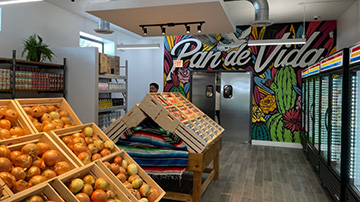
Responding in times of crisis
After years of staying relatively stable, food prices started to rise in 2020 amid the pandemic. Prices continued to climb in fiscal year 2022 due to rising fuel and labor costs, supply chain disruptions and the war in Ukraine.
The impact on many families was hard. Households already at risk of food insecurity before the pandemic were falling farther behind. And many of our neighbors were finding it challenging to put food on the table.
One in five Chicago households are currently experiencing food insecurity. The Food Depository’s network served 14% more households in June 2022 than the same month last year.
Our neighbors were trying everything they could to keep up with the rising food prices. Robert Costner, 65, has been attending the PAV YMCA’s bimonthly, drive-up food distributions in Berwyn for almost two years. Costner said lately he has been feeling the pinch on his wallet. “You do what you can to keep up with food prices,” he said. “You watch out for the sales. And you come to community events like this where they’re giving out free food. It helps a whole lot.”
Elevated food prices are not just challenging those on fixed or no income. Working households are also finding it hard to afford groceries. Any income they have is not stretching as far as it once did.
“Families that are working are still not making enough. They’re left to choose the basics. Do you want to survive? Do you want to pay your rent? Do you want to eat?”
Aber Abueid, SANAD Food Pantry Manager
Aber Abueid runs the SANAD Food Pantry in Chicago Lawn, serving households like Robertina Pacheco’s who recently started turning to her local food pantry to help fill her fridge at home. Pacheco’s husband and 23-year-old son work full time, but Pacheco lost her housekeeping job earlier in the pandemic. With no government assistance, the food she finds at the pantry helps alleviate the stress from additional expenses.
“Los ingresos no son suficientes,” she said. “Our income is not enough.”
Founded more than 30 years ago by Abueid’s mother, Fatima, the SANAD Food Pantry has come a long way since its humble beginnings serving neighbors out of a one-bedroom apartment. Today, it has grown into a vital resource for the community and now operates from a storefront on the corner of 63rd and Albany.
SANAD played a vital role in keeping community members fed during the pandemic. It went from serving around 300 households a month to nearly 20,000 people during the first three months of COVID.
Today, it continues to meet the needs of its neighbors. Except now, what’s keeping households lined up around the corner of 63rd Street is inflation, elevated prices for food, gas, housing and other necessities which are making it even more difficult for families to get by.
And with food prices likely to remain high at least until the end of 2022, if not longer, network partners like SANAD are bracing themselves for the increased community need to continue.
“Typically, retail prices are much quicker to go up than they are to come down,” explained Michael McFaul, the Food Depository’s senior director of procurement. “Even after we reach peak inflation, it may take months for food prices to stabilize and for consumers to feel some relief in their grocery bills.”
Similarly, the Food Depository has been impacted by rising inflation and supply chain disruptions. In fiscal year 2022, we spent a total of $36.8 million on food purchasing to ensure our partners shelves remained stocked. That was a 62% increase compared to what was spent in fiscal year 2021, and more than triple what was spent in fiscal year 2020. The temporary shift in our procurement strategy was due to rising food prices, increased demand and as donated food and government food supplies have decreased.
Thanks to the generosity of supporters, the Food Depository was able to keep up with rising food costs amid increased demand. Through their contributions, we continued to leverage our buying power as a food bank by purchasing in bulk to get the best bargains.
We also made adjustments to what we purchased, opting for more cost-effective alternatives. For example, we switched out pouched diced chicken for chicken drumsticks and downsized egg sizes from large to medium. Our team is constantly evaluating and looking for creative ways to make the most savings. We’re also looking to source more locally and directly with suppliers, where possible, to eliminate transportation costs, etc.
These measures and others will help the Food Depository weather inflation, as the need for food in the community persists well into fiscal year 2023.




